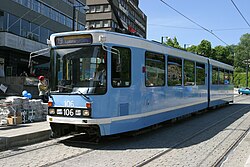SL79
| SL79 | |
|---|---|

SL79/I 106 at Nationaltheateret tram stop.
|
|
| In service | 1982– |
| Manufacturer |
Duewag (25) Asea Brown Boveri (15) |
| Built at |
Duewag (10) Strømmen (30) |
| Replaced | Gullfisk |
| Constructed | 1982–83, 1989–90 |
| Number built | 40 |
| Fleet numbers | 101–140 |
| Capacity | 162 |
| Operator(s) | Sporveien Trikken |
| Depot(s) | Grefsen, Holtet |
| Line(s) served | 11, 12, 19 |
| Specifications | |
| Car body construction | Steel |
| Car length | 22.180 m (72 ft 9.2 in) |
| Width | 2,500 mm (98 in) |
| Floor height | 880 mm (35 in) |
| Entry | 3-step stairs |
| Doors | Four |
| Maximum speed | 80 km/h (50 mph) |
| Weight | 32.8 tonnes (32.3 long tons; 36.2 short tons) |
| Traction system | Thyristor drive |
| Traction motors | NEBB 4ELO 2054 B |
| Power output | 434 kW (582 hp) |
| Acceleration | 1.3 m/s2 (4.3 ft/s2) |
| Deceleration | 1.3 m/s2 (4.3 ft/s2) |
| Electric system(s) | 750 V DC Overhead wire |
| Current collection method | Pantograph |
| Track gauge | 1,435 mm (4 ft 8 1⁄2 in) |
SL79 is a class of 40 articulated trams operated by the Oslo Tramway of Norway. The trams were a variation of the Duewag trams that had been developed by the German manufacturer since the 1950s. The six-axle vehicles are unidirectional with four doors on the right side. The trams can seat 77 passengers three and four abreast, with an additional 91 people able to stand. Power output is 434 kilowatts (582 hp), provided by two motors on the two end bogies, that supplement a central unpowered Jacobs bogie located under the articulation. The trams are 23.0 metres (75.5 ft) long and 2.5 metres (8 ft 2 in) wide. They are capable of 80 kilometres per hour (50 mph) and have standard gauge.
They were built in two series, the first of 25 units delivered in 1982–84, and the second of 15 units delivered in 1989–90. The first 10 units were built by Duewag, while the last 30 were built in Norway by Strømmen. They were numbered 101 through 140. The two series vary slightly in specifications. The trams were ordered in 1979 after the 1977 decision to not close the tramway, after the SM53 were finished delivered in 1958. The SL79 mainly serves on lines 11, 12 and 19. Except those with an advertising livery, the trams are painted a light blue.
In 1960, the Oslo City Council decided to gradually close the tramway. New trams had been delivered in 1958, and it was decided that lines would only be closed as trams were naturally retired. At the time Oslo Sporveier had 421 vehicles. By 1974, the company had 163 vehicles, of which 100 were powered trams, 43 were trailers and 20 were working trailers. Following the energy crisis in the 1970s, the political climate changed, and in 1977 the city council decided to not close the tramway anyway. Between 1978 and 1981, ten tram vehicles were bought from the Gothenburg Tramway.
In the 1950s, Duewag started to develop an articulated variation of its four-axle Großraumwagen, based on articulation technology used by trams in Rome. This design was delivered to many tramways, particularly in Germany. In 1977 and 1978, Oslo Sporveier tested a Duewag GT8S (3052) tram from Rheinbahn. In 1979, Oslo Sporveier ordered ten vehicles from Duewag, with planned delivery in 1982. In addition, fifteen units would be license-built by Strømmens Verkseted, with delivery the following year. All the motors were built by the Norwegian company Norsk Elektrisk & Brown Boveri (NEBB). The trams built in Germany were transported to Oslo by railway. The first vehicle was delivered on 13 April 1982 and put into service on 2 July. The last German-built tram was put into service on 13 September. The German trams were numbered 101 through 110. Oslo was the third tramway in the world to take into use thyristor controlled motors on the main part of their fleet of trams, after the systems in Helsinki, Finland, and Hanover, Germany.
...
Wikipedia
